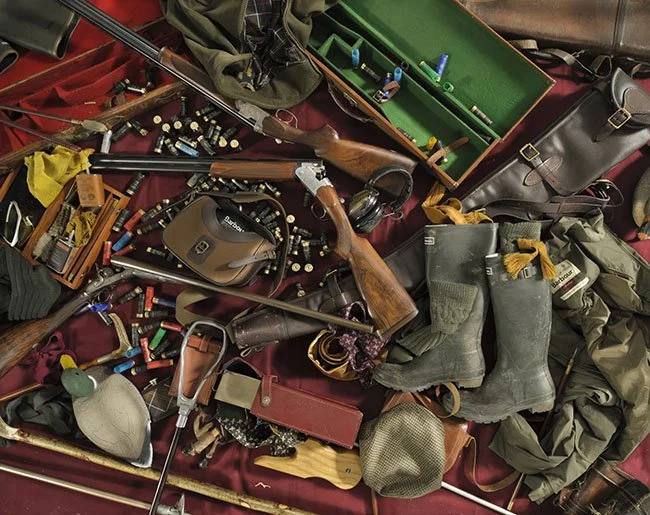Tabletop ads
Back in the days of having the studio, I was presented with the odd “special” task which provided a break from the thousands of repetitive product shots of clothes on mannequins, or handbags & shoes on a white perspex surface. This particular brief was to create a number of images which were being used as tabletop features on which to place products in worldwide stores. There were four themes altogether – equestrian, hunting, textiles, and fishing. For each theme, I was given a load of random props for a couple of days, and had to experiment with a composition that looked pleasing to the eye.
Creating the set was the first challenge. I decided to shoot on the wood floor, and needed a space of about 6ft x 4ft to fit everything in properly. I needed to shoot directly from above, so no tripod could be used that allowed this to happen. The 9ft studio stand came into play, with the horizontal arm extended to it’s full length. I used my old Nikon D3, with a 24mm PC-E lens fitted. This would allow the frame to be captured in two parts, which would be stitched together in post production giving a bigger file size for high resolution printing. Nowadays, I could shoot with a D800 and capture the frame in way more detail in one shot. Times change.
Next job was getting the objects in the frame, and moving them about until it looked pleasing. This is probably the most difficult, and time-consuming aspect of the whole process. The reason I never made it big as a studio product photographer is the fact that I failed to build the cost of this time into any brief, so ended up working for weeks at a time without any payment, despite actually working very long days. Stupid really, but it’s the devaluation of the trade in the eyes of clients that has brought about the situation of photographers having to work 75% of their week completely without reimbursement. It’s like a plumber charging for the materials they use with a bit of a markup, but not charging for any of their time. Your bathroom being purchased and fitted over a week would cost you £500 using the same principle. Happy days, and you’d just use a different plumber the next time, because the old one lasted two years. the only commercial photographers who are making a living are the ones who have alternative incomes doing weddings, or those who became established in the 1990’s. the rest of us are generally being taken for mugs by a client base that is happy to exploit fauxtographers who stick a watermark on their shit, over-processed Facebook landscape photos. I digress.
Lighting is next. The request was to keep things fairly flat for VM purposes, so I had a single softbox at one side, angled across the scene with a big white reflector at the other. It was a powerful 1500J strobe positioned quite some distance away. The distance was important, as the inverse-square law meant that there was very little light fall-off from one side to the other. Physics is wonderful. The next bit was interesting. I wanted to highlight certain aspects of the scene, so needed to do a bit of light painting here and there. Unfortunately, you need almost pure darkness to do this with any degree of control, and it was summer, so I would have had to wait until almost midnight without moving absolutely anything to do this. so decided to tackle the job in post production instead. Just a job of adding some highlights and shadows in Lightroom using the local brush tool.
Here are some of the unedited images supplied:
The final output was made brighter, more contrasty, and printed onto plastic laminate – to be affixed to the surfaces of old work benches. No pics of the final thing I’m afraid, although I did have one of the plastic panoramas on the studio wall once they’d been used and discarded. This job went so well that I was commissioned to do some more for a different campaign later on. Good times.


